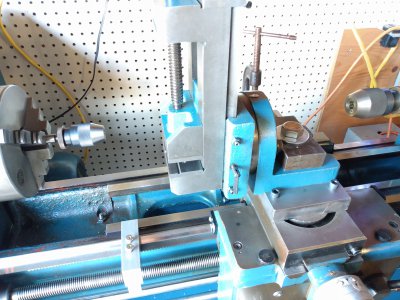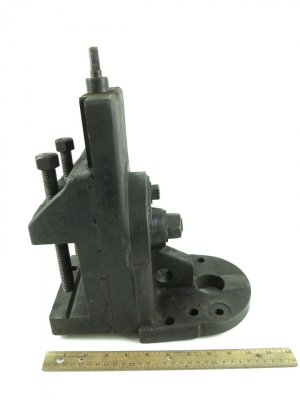- Joined
- Sep 25, 2018
- Messages
- 33
I know there’s a fair amount of interest in lathe milling attachments, especially in hobby and home machine shops. I’ve always had a fascination with them, but never had the chance until recently to use one. As discussed in other threads, a lathe milling attachment is truly no substitute for an actual Milling Machine. It does, however, allow the lathe operator to perform light duty milling, and in some cases they are very handy and worthwhile.
For years I had hoped to find one, and I recently came across not just one, but TWO milling attachments. I decided to buy them since I could use one on my Logan 922 11’ swing lathe and the larger one on my Logan 6560 14” swing lathe.
I ended up with the Palmgren 250 and the Palmgren 400.
The 250 and 400 designations are because of the respective jaw widths - 2.5” and 4"
The overall size difference between the 250 and 400 is enormous. The 400 is more than double the overall size, and is far more rigid. The 250 has only one lock for the graduations allowing the milling attachment to cut angles. The 400 has two. The 400 has nearly double the material at every point, and is in my opinion truly a capable milling attachment, whereas the 250 is extremely limited.
I decided to film a comparison video showing the differences in more detail, and also showing each one installed on a machine and taking a light cut.
I hope its helpful to anyone thinking about purchasing a milling attachment.
I’m very interested in the Atlas Lathe Milling Attachments as well. I no longer have an Atlas, but I believe the Atlas proprietary milling attachment is much better designed than the Palmgren, because the Atlas mounts directly to the cross slide, whereas the Palmgren requires the compound. There are a few advantages and disadvantages to each, but I think I like the Atlas design better.
If you have a milling attachment, do you use it often? What are your thoughts?
For years I had hoped to find one, and I recently came across not just one, but TWO milling attachments. I decided to buy them since I could use one on my Logan 922 11’ swing lathe and the larger one on my Logan 6560 14” swing lathe.
I ended up with the Palmgren 250 and the Palmgren 400.
The 250 and 400 designations are because of the respective jaw widths - 2.5” and 4"
The overall size difference between the 250 and 400 is enormous. The 400 is more than double the overall size, and is far more rigid. The 250 has only one lock for the graduations allowing the milling attachment to cut angles. The 400 has two. The 400 has nearly double the material at every point, and is in my opinion truly a capable milling attachment, whereas the 250 is extremely limited.
I decided to film a comparison video showing the differences in more detail, and also showing each one installed on a machine and taking a light cut.
I hope its helpful to anyone thinking about purchasing a milling attachment.
I’m very interested in the Atlas Lathe Milling Attachments as well. I no longer have an Atlas, but I believe the Atlas proprietary milling attachment is much better designed than the Palmgren, because the Atlas mounts directly to the cross slide, whereas the Palmgren requires the compound. There are a few advantages and disadvantages to each, but I think I like the Atlas design better.
If you have a milling attachment, do you use it often? What are your thoughts?



